These pictures were taken at the Carl Sauter Piano in Spaichingen in February 2008. You may click on any picture for a larger version.
| |
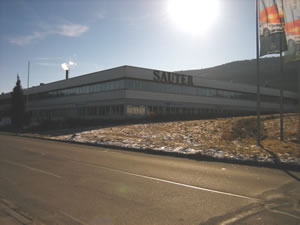
View of the factory looking ESE. The production area occupies the first floor (second floor in the States). Administrative offices are located on the ground floor. |
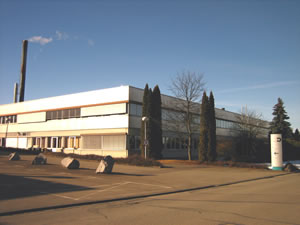
View look towards the SSW. |
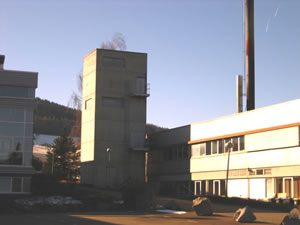
Waste wood is stored in this silo. Up until a few years ago, it was used as fuel to heat the factory. Now, due to industrial environmental regulations, this waste wood can not be used as fuel but rather must be disposed of. |
|
|
|
| |
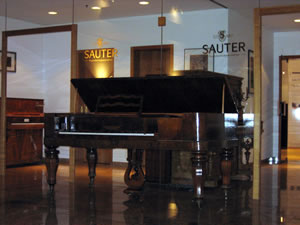
The foyer of administrative offices contains examples of pianos dating back to the 1830's. |
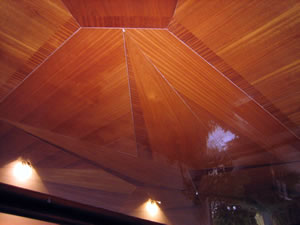
The ceiling of the foyer is used to highlight many of the wood veneer finishes which are used in piano production. |
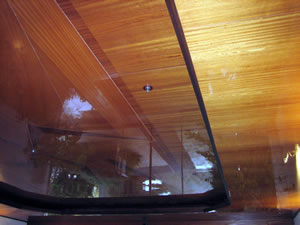
More veneer samples. |
|
|
|
| |
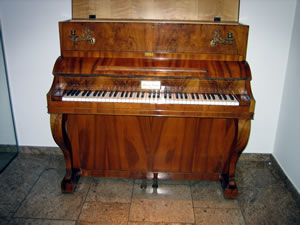
This is the earliest piano in the showroom. It was produced circa 1830 in the Biedermeier ( Deutsch) style. It was made by Johann Grimm who apprenticed in Vienna with Johann Andreas Streicher. All the pianos with the exception of the square piano are quite playable. |

This square piano was made circa 1860. It is all original, however, it requires restoration. This piano is was featured in the video which the factory produced. This piano is serial number 572. |
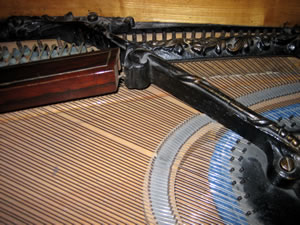
Close up of square piano action. The piano could be played well enough that I was able to get an idea about how it worked and even how it sounded. I was particularly interested in the damper design. Modern pianos have certainly come a long way. |
|
|
|
| |
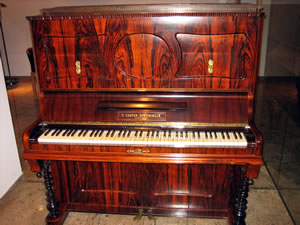
This upright piano, finished in Brazilian rosewood, was also manufactured circa 1860. Its serial number is 549. |
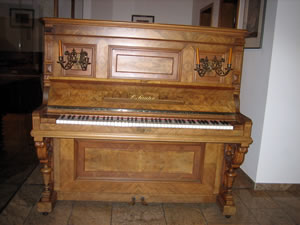
This piano was built in the 1890's and was recently restored. It is finished in natural Caucasian walnut. It was acquired from a nearby parish and had been painted with black lacquer. |
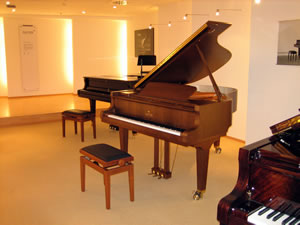
Adjacent to the foyer area, is the factory showroom. There were seven pianos in this area. All the grand pianos were Delta 185's. This piano is a satin finish walnut, presumably black walnut. In the background is an ebony and in the foreground is a polished pyramid mahogany. |
|
|
|
| |
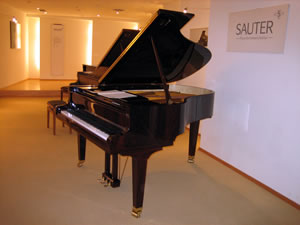
This is the polished pyramid mahogany Delta 182. While all of the Delta's sounded and played great, I gravitated to this piano in the end and played it for about a half an hour. It would have been longer but my office called and it needed my attention. |
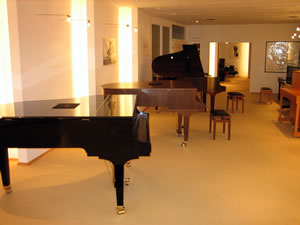
Another view with the polished ebony Delta in the foreground. |
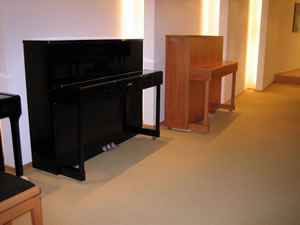
A Vision 116 and a Vista 122. I didn't play either of these two pianos but I did play the Microtonal piano just peaking from the left side of this photo. The Microtonal has 97 keys which span only one octave. A fifth is equivalent of a normal piano's semitone. The capo on this piano is a straight line. I can only describe this piano as disorienting. Very cool. Here is a link to publishers site with sound snippets which was recorded using one of these pianos. |
|
|
|
| |
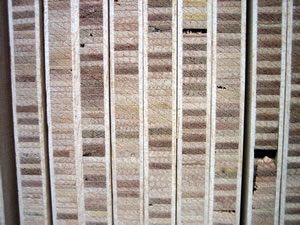
The tour of the factory was led by Ulrich Sauter and it was logical to start at the back door where the raw materials are received. This material is used for lids and other similar applications. I couldn't resist this shot mostly because it reminded me of a stained DNA sequences, the "genes" of a piano. |
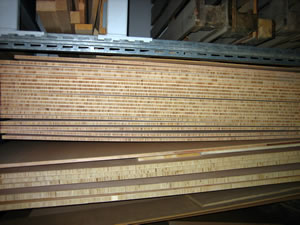
These sheets are produced in different thickness depending upon need. |
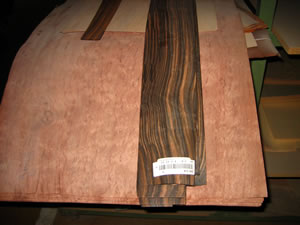
This veneer strip is Macassar Ebony. Pianos can be built with any veneer on special orders. This one particularly caught me eye. |
|
|
|
| |
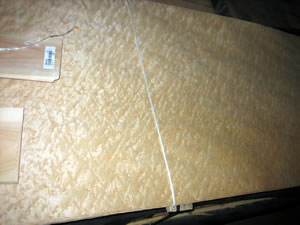
Here's some birds eye maple waiting for someone's piano.
|
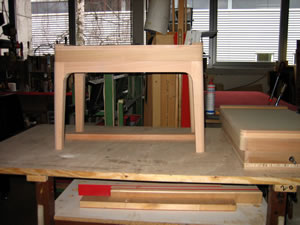
In the prototyping area, here is a new bench that is being developed.
|
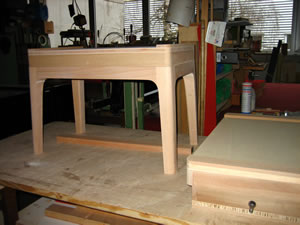
The bench is a commissioned design.
|
|
|
|
| |
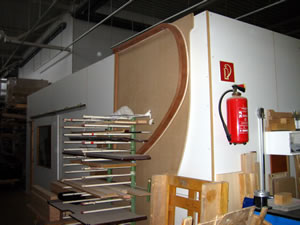
Hanging on the wall in this picture is the router template for the Ambiente 230. I saw this piano at the NAMM 2008 show. It shares the same plate with the Omega 220.
|
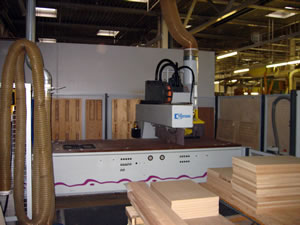
The factory contained a wide variety of woodworking machinery. This CNC router is at the heart of much of the production process.
|
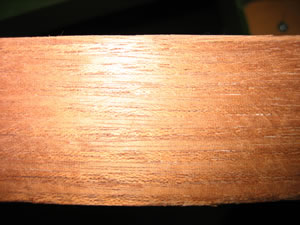
This is a close up of a rim. Rims are built entirely of mahogany and consist of up to 15 layers depending upon the model. In the past, the rims were built with alternating plies of mahogany and beech but it was found that mahogany alone provided a better glue joints.
|
|
|
|
| |
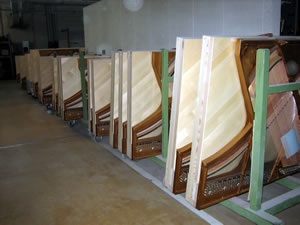
These are strung backs for upright pianos. The strings are tensioned to nearly a tuned state (yes, I pluck a few of them) and "rest" in this state for about six to eight weeks to get the subassembly into stable state. The factory humidity is regulated to 45%RH. During the rest, these backs adjust to their role and may twist ever so slightly. After they have rested, they are placed on the CNC router and squared up. This places no stress on the casework and hence none on the main sound producing elements of the piano as well and leads to long term stability. The same is done for grand pianos as well.
|
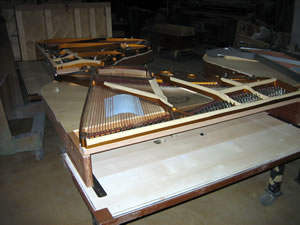
This is an Delta subassembly. Like the uprights in the preceding picture, they are tensioned and rest for a period of time to stabilize before further production processes. Somewhat unique in the industry, Sauter grand pianos have a inner rim which is built separately from the outer rim. The soundboard thus maintains its dimensions without any influence by the outer rim. Also visible in this photo are the Delrin blocks which are embedded into the keybed. The grand pianos plates are cast in Germany at Funk Guss in Aalen (East of Stuttgart, about 190km from Spaichingen).
|
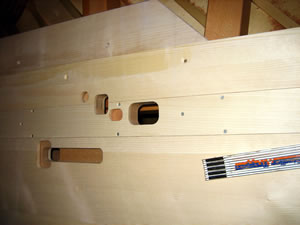
This is the keybed of an Omega 220. Notice that this piano has been setup to receive an optional player system (screwed insert). This process allows for maintaining the Sustenuto pedal function in player installation.
|
|
|
|
| |
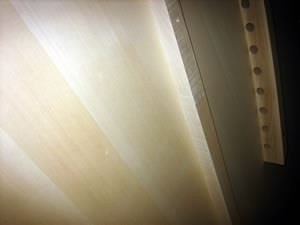
This is an Omega 220 soundboard and bridge. Omega soundboards are produced by Cireza in Italy. Soundboards for all other models are provided by Strunz.
|
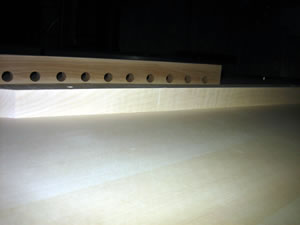
Another view of an Omega soundboard and bridge.
|
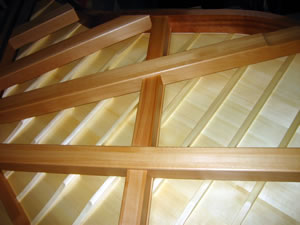
Underside of an Omega 220.
|
|
|
|
| |
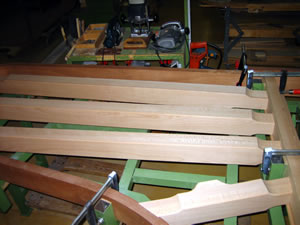
Bracing for a Konzert 275.
|
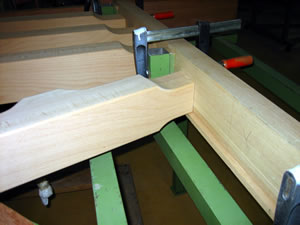
Detail of 275 bracing.
|
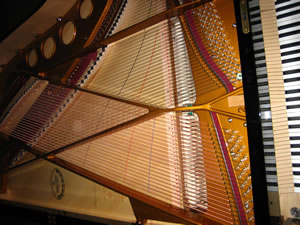
An Omega 220 nearing completion, here without dampers. This piano seemed alive when we approached it. I wonder where this one is destined?.
|
|
|
|
| |
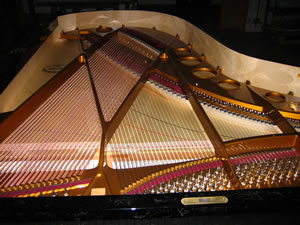
Another shot of the Omega nearing completion.
|
I don't have a picture of a very interesting carbon fiber soundboard prototype which was developed by Sauter a few years ago.
I was told that it had a tremendous amount of volume but no real character. I don't think that they have completely shelved the idea, though.
Maybe I'll get a picture of it next time I'm there.
|
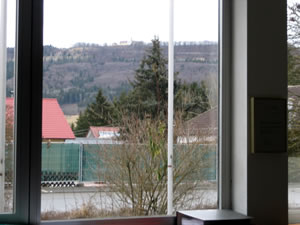
Final shot is the view of Dreifaltigkeitsburg. I was interested in seeing this as my grandmother often spoke of it. I didn't have a chance on this trip to actually tour the monastery. I had to have at least one more reason to visit again.
|
|
|
|
|
|
|
Return to Spaichingen 2008 |
| |
Copyright © 2008 E J Sauter
|
|


































